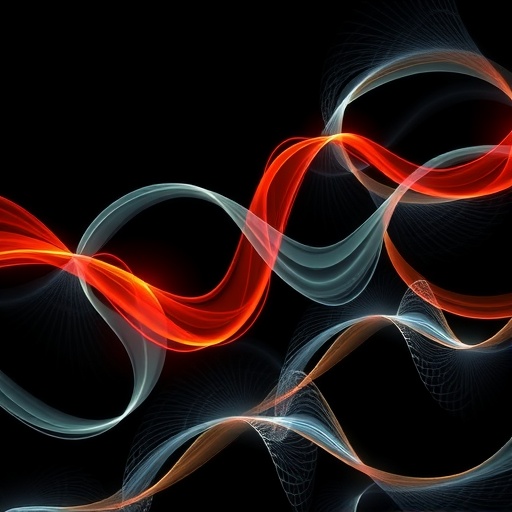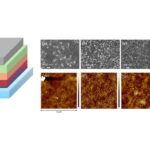
In recent years, the exploration of topological phenomena in synthetic quantum systems has revolutionized our understanding of materials and wave dynamics. Now, groundbreaking research led by Yang, Liao, Zhang, and their collaborators pushes the frontier even further by experimentally demonstrating half-integer topological winding numbers in non-Hermitian synthetic lattices. Published in Light: Science & Applications (2025), their study unveils unconventional topological invariants that were long thought to be prohibited within standard Hermitian frameworks, thereby challenging established topological classifications and promising new avenues for photonic devices and quantum simulators.
Topological winding numbers serve as fundamental descriptors that characterize the global geometric and topological properties of physical systems. In canonical Hermitian systems — where the Hamiltonian operators guarantee real energy spectra and orthogonal eigenstates — winding numbers are traditionally integer-valued, reflecting robust and quantized features immune to perturbations. The discovery of half-integer winding numbers in non-Hermitian settings, as reported by Yang et al., marks a paradigm shift that redefines how symmetry, gain, and loss interplay in engineered lattices.
The core innovation hinges upon the use of synthetic lattices, which employ carefully constructed optical or quantum platforms that simulate lattice Hamiltonians in a controllable manner. Unlike real crystalline materials, synthetic lattices allow for fine-tuned adjustments of parameters such as coupling strength, gain and loss mechanisms, and lattice geometry. By exploiting these degrees of freedom, the team engineered non-Hermitian Hamiltonians that break conventional symmetry conditions, thereby enabling exotic topological states to emerge with previously unattainable winding numbers.
.adsslot_dYpQe0kvsu{width:728px !important;height:90px !important;}
@media(max-width:1199px){ .adsslot_dYpQe0kvsu{width:468px !important;height:60px !important;}
}
@media(max-width:767px){ .adsslot_dYpQe0kvsu{width:320px !important;height:50px !important;}
}
ADVERTISEMENT
Non-Hermitian physics, a domain capturing systems with asymmetric and complex potentials, has revealed rich unconventional behavior over the past decade—including exceptional points, parity-time symmetry breaking, and unique skin effects. However, the direct observation of half-integer topological invariants remained elusive until now, largely due to experimental challenges in isolating such effects from noise and ensuring precise control over system parameters. Yang and colleagues designed an ingenious experimental platform utilizing photonic waveguides with tailored gain and loss distributions that faithfully realized the theoretical model predicting half-integer winding numbers.
The methodology involved constructing arrays of coupled waveguides fabricated in silica, where individual waveguides could be selectively pumped to introduce gain while neighboring channels experienced complementary loss. This controlled non-Hermitian environment created complex energy bands whose topology transcended standard paradigms. State-of-the-art measurement techniques captured the evolution of light within the lattice, revealing winding trajectories in parameter space that corresponded unmistakably to half-integer quantized values.
One of the remarkable aspects of this work is the reconciliation of half-integer topological indices with physical observables. Traditionally, half-integers have appeared as mathematical artifacts or in more abstract contexts such as fractional quantum Hall states or spin systems. Here, the demonstration that non-Hermiticity inherently splits the winding number spectrum enriches the taxonomy of topological phases and invites reconsideration of topological protection mechanisms under non-reciprocal and dissipative conditions.
The implications of these findings extend across condensed matter physics, photonics, and quantum information science. For photonic systems, leveraging half-integer winding numbers opens up novel routes for robust light guiding, delay lines, and mode conversion processes unaffected by moderate fabrication imperfections. Unlike their Hermitian counterparts, non-Hermitian topological states accommodate directional amplification and attenuation, which could be harnessed to design new classes of optical isolators and sensors with unprecedented sensitivity.
Furthermore, the experimental platform offers a fertile testbed for exploring other unconventional topological phenomena predicted theoretically but not yet observed. By systematically tuning non-Hermitian parameters, researchers can map out phase diagrams enriched with unique exceptional points, spectral singularities, and novel edge states. This enables a deeper understanding of how dissipation and topology interrelate, laying groundwork for devices that exploit loss and gain rather than merely mitigating them.
The interface with quantum simulation is equally exciting. Synthetic non-Hermitian lattices effectively mimic open quantum systems where energy exchange with the environment cannot be neglected, making these setups ideal for probing quantum dynamics beyond isolated ideal models. The half-integer winding numbers reveal new symmetries and invariants that could influence how quantum coherence, entanglement, and information flow behave under realistic conditions with decoherence and dissipation.
In addition to experimental sophistication, the theoretical formulation underpinning this study employs advanced mathematical tools such as biorthogonal eigenbases and complex spectral flows. The team managed to rigorously prove the stability of half-integer winding numbers under continuous deformations, highlighting their robustness as topological invariants within the non-Hermitian regime. This addresses a central question about whether generalizations of topological order can withstand practical imperfections and parameter drifts.
Importantly, the authors contrasted these findings with known Hermitian lattice models, underscoring the uniqueness of non-Hermitian topology. While integer winding numbers arise naturally from the mapping of momentum space to the unit circle, here the introduction of non-Hermiticity modifies the spectral geometry, allowing disconnected or multi-valued branch cuts associated with half-integer quantizations. This subtle yet profound alteration expands the conceptual framework of topological phases.
The experimental results are visually striking, showing winding trajectories that enclose half of the Brillouin zone in a manner incompatible with classical Hermitian constraints. This not only supports the theoretical predictions but also invites spirited discussions on the physical intuition behind these phenomena. Conceiving a half-integer winding number as a fractional wrapping in parameter space challenges the notion of ‘quantization’ itself, as it emerges dynamically due to non-Hermitian asymmetry rather than explicit symmetry breaking.
Looking forward, this discovery stimulates intriguing questions about how such topological phases behave under interactions and many-body effects. Could strongly correlated non-Hermitian systems exhibit fractional winding numbers with associated fractionalized excitations or anyonic statistics? These avenues may open up a novel subfield linking topological quantum matter with open quantum systems and dissipative engineering.
This landmark work also sets a new benchmark for experimental precision and control in synthetic quantum matter. The ability to engineer and probe subtle topological features that are invisible in traditional systems attests to rapid advances in nanofabrication, optical engineering, and measurement technology. Furthermore, it paves the way for integrating non-Hermitian topological elements into practical device architectures, such as integrated photonic chips designed for computation, communication, and sensing in inherently lossy environments.
In conclusion, Yang et al.’s observation of half-integer topological winding numbers in non-Hermitian synthetic lattices constitutes a significant leap in the study of topological physics. By transcending the orthodox integer quantization paradigm, the research opens fresh conceptual and practical horizons in the control of wave dynamics and quantum states. The confluence of theory and experiment in this study exemplifies how synthetic platforms can reveal hidden states of matter, expanding our technological toolkit and deepening our comprehension of the quantum world’s complexity.
Subject of Research: Observation of half-integer topological winding numbers in non-Hermitian synthetic lattices.
Article Title: Observing half-integer topological winding numbers in non-Hermitian synthetic lattices.
Article References: Yang, M., Liao, YW., Zhang, HQ. et al. Observing half-integer topological winding numbers in non-Hermitian synthetic lattices. Light Sci Appl 14, 225 (2025). https://doi.org/10.1038/s41377-025-01909-8
Image Credits: AI Generated
DOI: https://doi.org/10.1038/s41377-025-01909-8
Tags: advancements in quantum materials researchengineered lattices with gain and lossexperimental demonstration of topological conceptsgeometric properties of physical systemshalf-integer topological winding numbersHermitian vs non-Hermitian physicsimplications for photonic devicesnon-Hermitian synthetic latticesquantum simulators with topological featuressynthetic quantum systemstopological invariants in materialstopological phenomena in photonics



